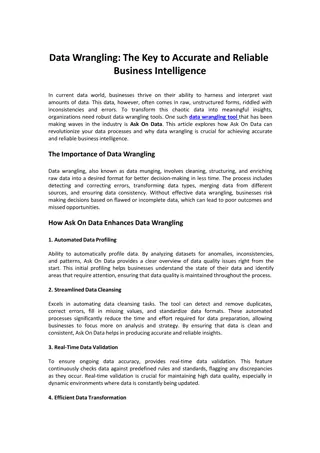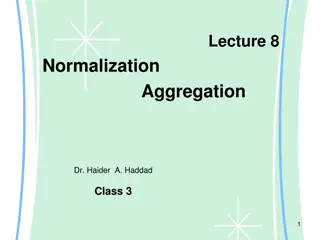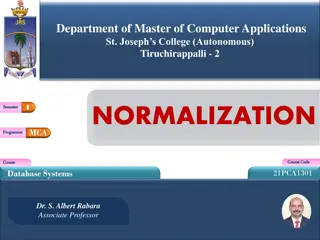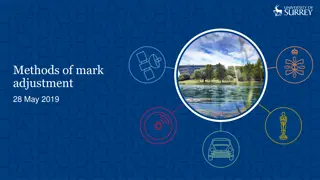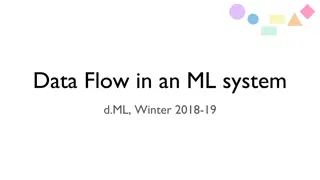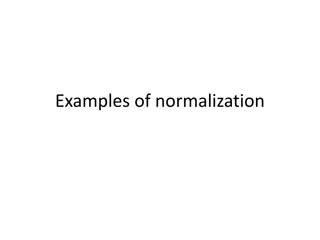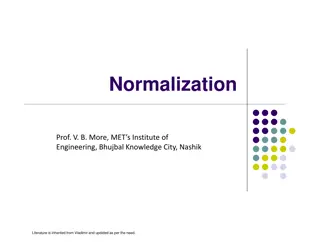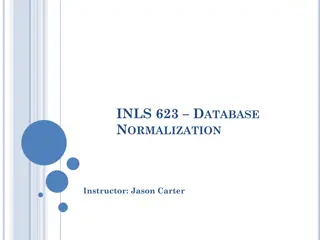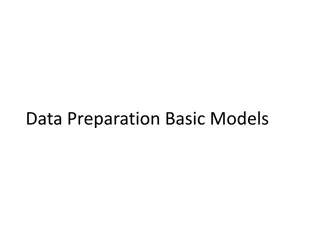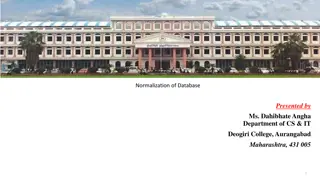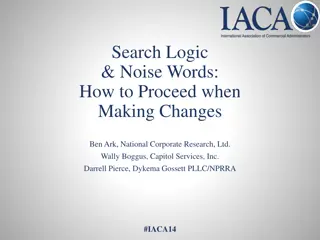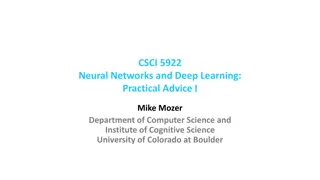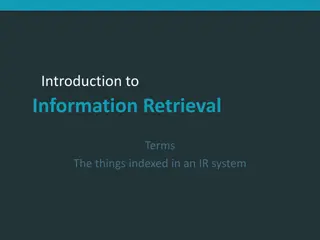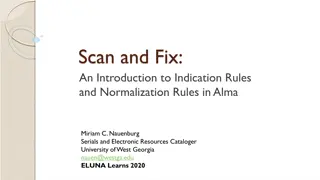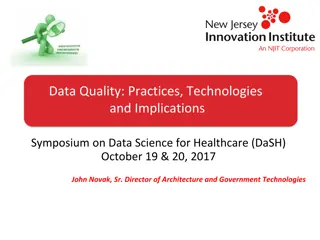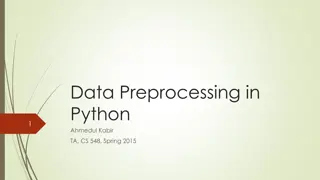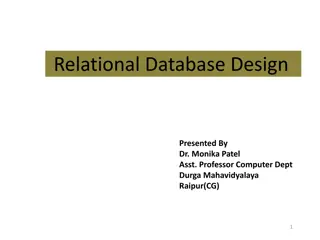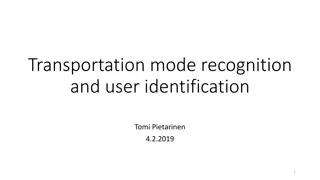Normalisation
Explore databases in detail and understand normalization. Learn how to structure data efficiently in databases for optimal performance. Research and discuss the importance of normalization.
1 views • 20 slides
Building a local facet in Primo VE for Decolonization work
Explore the process of adding publisher/place of publication as a search parameter in Library Search, with insights on using MARC fields, establishing normalization rules, and steps to enable and translate local fields for effective faceted searching in Primo VE. Learn about the nuances of field rec
0 views • 19 slides
fMRI Coregistration and Spatial Normalization Methods
fMRI data analysis involves coregistration and spatial normalization to align functional and structural images, reduce variability, and prepare data for statistical analysis. Coregistration aligns images from different modalities within subjects, while spatial normalization achieves precise anatomic
3 views • 35 slides
Coregistration and Spatial Normalization in fMRI Analysis
Coregistration and Spatial Normalization are essential steps in fMRI data preprocessing to ensure accurate alignment of functional and structural images for further analysis. Coregistration involves aligning images from different modalities within the same individual, while spatial normalization aim
6 views • 42 slides
Struggling with Data Accuracy_ Implement These Data Cleansing Techniques in Your BI Software
Explore essential data cleansing techniques that can significantly improve the accuracy and reliability of your Business Intelligence software. This guide offers practical advice on implementing normalization, deduplication, validation, and more, ensuring that your data is not just voluminous but tr
7 views • 7 slides
Using BIBFRAME in a mixed MARC environment
Delve into the intricate world of utilizing BIBFRAME alongside MARC standards at the National Library of Sweden. Discover the benefits of a BIBFRAME catalog, the challenges of maintaining dual terminology, and the ongoing shift towards linked data integration. Gain insights into cataloging practices
0 views • 10 slides
Ask On Data for Efficient Data Wrangling in Data Engineering
In today's data-driven world, organizations rely on robust data engineering pipelines to collect, process, and analyze vast amounts of data efficiently. At the heart of these pipelines lies data wrangling, a critical process that involves cleaning, transforming, and preparing raw data for analysis.
2 views • 2 slides
Data Wrangling like Ask On Data Provides Accurate and Reliable Business Intelligence
In current data world, businesses thrive on their ability to harness and interpret vast amounts of data. This data, however, often comes in raw, unstructured forms, riddled with inconsistencies and errors. To transform this chaotic data into meaningful insights, organizations need robust data wrangl
0 views • 2 slides
Understanding Patient Health Record Linkage Methods
Explore the methods and processes involved in linking patient health records to ensure data accuracy and integrity. Learn about objectives, data de-duplication, encryption, data normalization, and linkage variables. Discover CU Record Linkage (CURL) data flow and key quality measures. Dive into data
2 views • 21 slides
Database Normalization and Aggregation Concepts
Understanding the advantages and disadvantages of database normalization, the concept of aggregation in the ER model, and examples of creating ER diagrams using aggregation rules with related entities. Explore the benefits of smaller databases and better performance through normalization, and how ag
4 views • 11 slides
Understanding Database Normalization and Functional Dependencies
Database normalization is a crucial process that aims to improve database design by organizing data into higher forms of normality. This helps in reducing redundancy and ensuring data integrity. Functional dependencies play a key role in defining relationships between attributes in a database. By un
0 views • 33 slides
Understanding Data Governance and Data Analytics in Information Management
Data Governance and Data Analytics play crucial roles in transforming data into knowledge and insights for generating positive impacts on various operational systems. They help bring together disparate datasets to glean valuable insights and wisdom to drive informed decision-making. Managing data ma
0 views • 8 slides
Methods of Mark Adjustment in Educational Assessment
In educational assessment, methods like Z-score normalization, quadratic scaling, and piecewise linear scaling are used to adjust marks based on Gaussian distribution assumptions. Z-score normalization helps to adjust both mean and standard deviation, impacting the distribution of marks. Quadratic s
4 views • 25 slides
Understanding Data Flow in Machine Learning Systems
Explore the intricate data flow within machine learning systems through the stages of data design, model building, data cleaning, and evaluation. Learn about the importance of data types, training data, and data normalization in creating effective machine learning models.
0 views • 27 slides
Understanding Database Normalization Process
Database normalization is a crucial process that helps in organizing data efficiently by reducing redundancy and dependency issues. It involves steps like identifying keys, removing repeating attributes, and transforming data into different normal forms. Each step aims to enhance data integrity and
0 views • 19 slides
FlashNormalize: Programming by Examples for Text Normalization
Text normalization is essential for converting non-standard words like numbers, dates, and currencies into consistently formatted variants. FlashNormalize offers a programming-by-examples approach for accurate normalization, addressing challenges posed by traditional manual methods and statistical t
6 views • 14 slides
Understanding Normalization in Database Management
Normalization is a crucial database design technique used to organize tables efficiently, reduce data redundancy, and prevent anomalies in data operations. This process involves decomposing larger tables into smaller, linked tables to ensure consistency and ease of data management.
1 views • 59 slides
Database Normalization: Understanding Sets and Normal Forms
Explore the importance of set theory in database design, learn about different types of sets, subsets, and supersets, understand the basics of normalization techniques to efficiently organize data in databases, and discover the common anomalies associated with unnormalized databases.
0 views • 26 slides
Understanding Data Preparation in Data Science
Data preparation is a crucial step in the data science process, involving tasks such as data integration, cleaning, normalization, and transformation. Data gathered from various sources may have inconsistencies in attribute names and values, requiring uniformity through integration. Cleaning data ad
1 views • 50 slides
Effect of Normalization of Relations with Cuba on Georgia
The normalization of relations with Cuba has had significant effects in Georgia, particularly in terms of diplomatic relations, trade embargo laws, and trade relations. This includes a look at the naming of ambassadors, the importance of diplomatic relations, trade restrictions with various countrie
0 views • 8 slides
Understanding Database Normalization: A Comprehensive Guide
Database normalization is a crucial process in database design to eliminate data redundancy and anomalies. This guide covers the definition of normalization, types of normalization including 1NF, 2NF, and more, along with examples and explanations on achieving each normalization form.
1 views • 22 slides
Understanding Database Normalization Techniques
Database normalization is a crucial technique for organizing data efficiently to eliminate redundancy and anomalies. It involves decomposing tables to ensure data integrity and minimize inconsistencies. Common issues without normalization include excessive memory usage and data manipulation problems
4 views • 21 slides
Optimizing Search Logic and Noise Handling in Data Processing
Explore the complexities of search logic and noise words in data processing, with insights from experts in the field. Discover how policies and special characters impact information management. Learn about strategies for name normalization and unique rules for handling individual names in data syste
0 views • 13 slides
Analyzing the 2015-2016 Sharks Season Using nOx (Net Opponent XG)
Explore how nOx (Net Opponent XG) sheds light on the performance of the 2015-2016 Sharks season, delving into goaltending statistics, game analysis, and team ratings based on historical data normalization. Learn about the calculations behind nOxG, the run to the finals, and the scapegoat in the form
0 views • 16 slides
Utilizing Integrated Measurements for Reservoir Fluid Characterization while Drilling
This presentation focuses on the integration of surface and downhole measurements to characterize reservoir fluids while drilling. Topics covered include mud gas data acquisition and evaluation, gas analysis while drilling, challenges in tight and abrasive formations, and environmental corrections s
0 views • 23 slides
Best Practices in Neural Network Initialization and Normalization
This resource provides practical advice on input normalization, weight initialization, Xavier normalization, and Glorot/Bengio normalization in neural networks. Tips include the importance of controlling the range of net inputs, setting initial weights appropriately, and understanding the rationale
0 views • 15 slides
Understanding Information Retrieval Techniques
Information retrieval involves various techniques such as stop words exclusion, normalization of terms, language-specific normalization like accents and date forms, and case folding to enhance search efficiency. These methods aim to improve query matching by standardizing and optimizing indexed text
0 views • 9 slides
Verification and Validation of FISPACT-II & General-Purpose Nuclear Data Libraries
The paper discusses the verification and validation of FISPACT-II and general-purpose nuclear data libraries presented at the UK National Conference on Applied Radiation Metrology. It covers new features of FISPACT-II, fusion decay heat experiments, uncertainty quantification, collaboration opportun
0 views • 17 slides
Understanding Batch Normalization in Neural Networks
Batch Normalization (BN) is a technique used in neural networks to improve training efficiency by reducing internal covariate shift. This process involves normalizing input data to specific ranges or mean and variance values, allowing for faster convergence in optimization algorithms. By standardizi
0 views • 18 slides
Basics of Hypothesis Testing in Gene Expression Profiling
The lecture covers the essential aspects of hypothesis testing in gene expression profiling, emphasizing experimental design, confounding factors, normalization of samples, linear modeling, gene-level contrasts, t-tests, ANOVA, and significance assessment techniques. Practical insights are shared on
0 views • 9 slides
Scan and Fix: Indication and Normalization Rules in Alma
Introduction to indication rules and normalization rules in Alma Miriam C. Nauenburg's presentation on the scan and fix workflow. Learn about creating and applying indication and normalization rules, testing rules in the Metadata Editor, and organizing rules as private or shared.
0 views • 54 slides
Data Quality Challenges in Healthcare: Addressing Standards and Consistency
The symposium on Data Science for Healthcare highlighted challenges such as incomplete demographics, lack of standard requirements, and inconsistent data collection methods. Issues like patient identifier standards, data normalization, and monitoring were also identified as crucial for improving dat
0 views • 13 slides
Progress Update on Nuclear Data Research at LLNL
Nuclear Data Advisory Group received an online report from Lawrence Livermore National Laboratory detailing progress on various projects, including thermal neutron scattering laws processing, fission data measurements, and PPAC fission chamber development for 240Pu. The report outlines successful te
0 views • 19 slides
Understanding Data Modeling for Optimal Performance
Data modeling is crucial for efficient relational and non-relational databases. It involves making decisions on normalization, denormalization, embedding, and referencing to optimize performance and minimize costs. By strategically structuring data, you can achieve the benefits of joins without the
0 views • 36 slides
Data Preprocessing Techniques in Python
This article covers various data preprocessing techniques in Python, including standardization, normalization, missing value replacement, resampling, discretization, feature selection, and dimensionality reduction using PCA. It also explores Python packages and tools for data mining, such as Scikit-
0 views • 14 slides
E-R Diagram and Normalization Analysis for Online Telephone Sales System
This content provides detailed information on the creation of an information system for tracking orders in an online telephone sales company. It includes system requirements, entity identification, attribute listing, relationship identification, and normalization analysis for second and third normal
0 views • 10 slides
Understanding Discriminative Normalization Flow in Machine Learning
Explore the intricacies of Discriminative Normalization Flow (DNF) and its role in preserving information through various models like NF and PCA. Delve into how DNF encoding maintains data distribution and class information, providing insights into dimension reduction and information preservation in
0 views • 23 slides
Understanding Relational Database Design Fundamentals
This content delves into the crucial aspects of relational database design, including normalization, pitfalls, RDBMS design issues, and the overall database design process. It emphasizes the need for well-structured relation schemas to minimize redundancy, ensure data integrity, and facilitate effic
1 views • 53 slides
Advanced Techniques for User Identification in Transportation Using GPS and Accelerometer Data
This research focuses on transportation mode recognition and user identification by analyzing GPS and accelerometer data. The study involves data collection from varying conditions with over 500 trips and 150 hours of data, processed using spatio-temporal techniques. Features such as mean, deviation
0 views • 33 slides
Understanding Database Normalization and BCNF in Database Systems
Learn about the process of database development, including E-R diagrams, converting to relations, developing database operations, normalization, and BCNF. Explore algorithms for achieving BCNF and example scenarios to understand key concepts in database systems.
0 views • 43 slides







